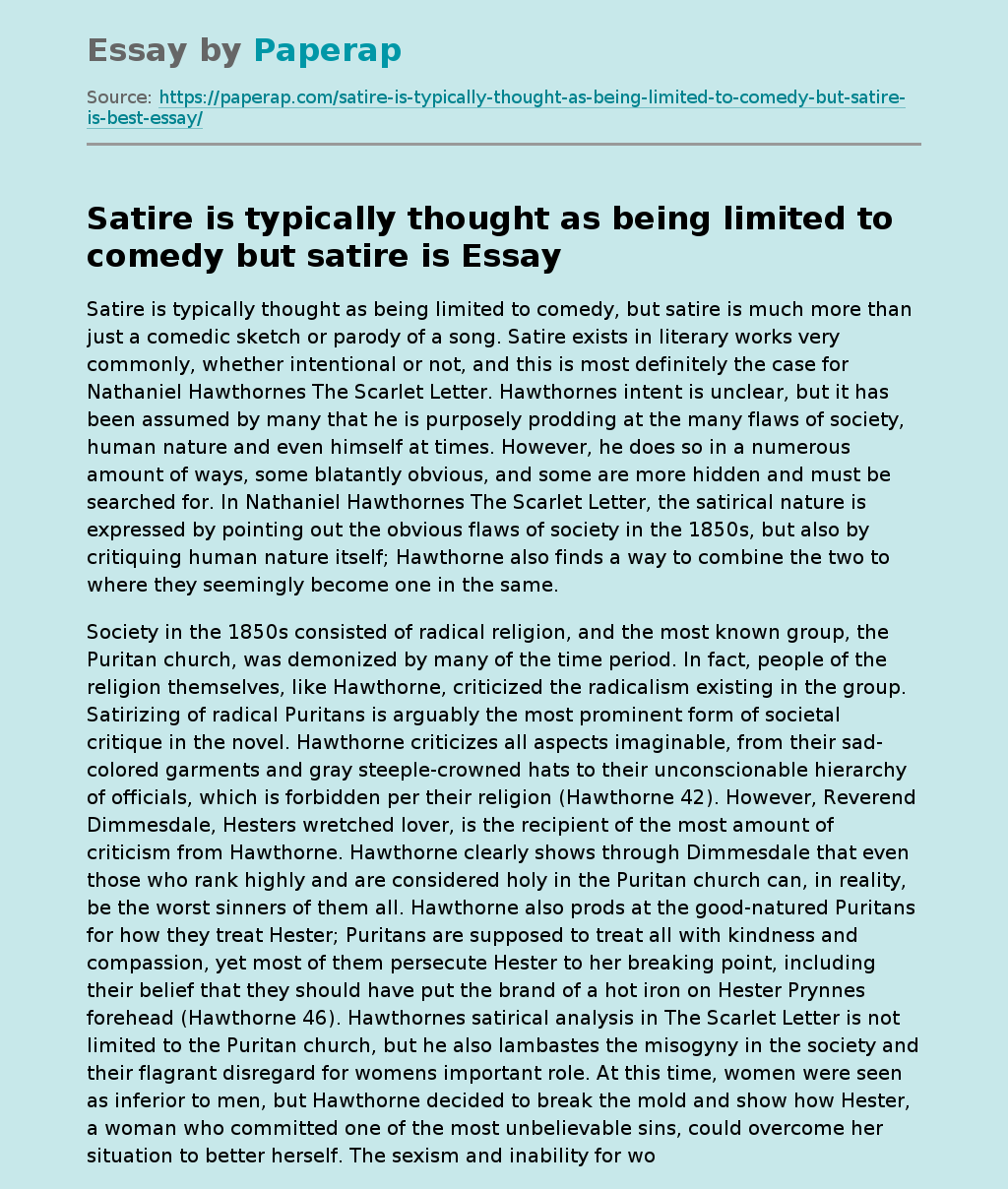Satire in The Scarlet Letter by Nathaniel Hawthorne
Satire is typically thought as being limited to comedy, but satire is much more than just a comedic sketch or parody of a song. Satire exists in literary works very commonly, whether intentional or not, and this is most definitely the case for Nathaniel Hawthorne’s The Scarlet Letter. Hawthorne’s intent is unclear, but it has been assumed by many that he is purposely prodding at the many flaws of society, human nature and even himself at times. However, he does so in a numerous amount of ways, some blatantly obvious, and some are more hidden and must be searched for.
In Nathaniel Hawthorne’s The Scarlet Letter, the satirical nature is expressed by pointing out the obvious flaws of society in the 1850s, but also by critiquing human nature itself; Hawthorne also finds a way to combine the two to where they seemingly become one in the same.
Society in the 1850s consisted of radical religion, and the most known group, the Puritan church, was demonized by many of the time period.
In fact, people of the religion themselves, like Hawthorne, criticized the radicalism existing in the group. Satirizing of radical Puritans is arguably the most prominent form of societal critique in the novel. Hawthorne criticizes all aspects imaginable, from their sad-colored garments and gray steeple-crowned hats to their unconscionable hierarchy of officials, which is forbidden per their religion (Hawthorne 42). However, Reverend Dimmesdale, Hester’s wretched lover, is the recipient of the most amount of criticism from Hawthorne. Hawthorne clearly shows through Dimmesdale that even those who rank highly and are considered holy in the Puritan church can, in reality, be the worst sinners of them all.
Hawthorne also prods at the good-natured Puritans for how they treat Hester; Puritans are supposed to treat all with kindness and compassion, yet most of them persecute Hester to her breaking point, including their belief that they should have put the brand of a hot iron on Hester Prynne’s forehead (Hawthorne 46).
Hawthorne’s satirical analysis in The Scarlet Letter is not limited to the Puritan church, but he also lambastes the misogyny in the society and their flagrant disregard for women’s important role. At this time, women were seen as inferior to men, but Hawthorne decided to break the mold and show how Hester, a woman who committed one of the most unbelievable sins, could overcome her situation to better herself. The sexism and inability for women to do manly things is even shown by Hester’s job as a seamstress where she derives a pleasure, incomprehensible to the other sex, from the delicate toil of the needle (Hawthorne 78). Nevertheless, Hester eventually understands her all-important role in the oppressive Puritan society surrounding her, and decides that she must escape it on order to live freely, further showing Hawthorne’s condemnatory attitude towards Puritans and the autocratic, sexist societies they create.
Hawthorne’s satirical outlook of human nature is also presented in The Scarlet Letter via the characters of the novel. The most common flaw addressed is the inability for people to forgive, whether it be themselves or an outside wrongdoer. This is a clear theme of the novel as both Hester and Dimmesdale severely struggle with the weight they feel they must carry for their sins. Although they claim to have forgiven each other and themselves, it is apparent throughout the story that neither have truly forgiven. Dimmesdale even more so than Hester feels that the judgement of God is on me and it is too mighty for me to struggle with (Hawthorne 186). Hester feels similarly; although the people of the town had refused to interpret the scarlet A by its original signification and now said it meant able, Hester had not forgiven herself, so she still saw it as a sign and punishment for her sin (Hawthorne 152). Through the conflict both Hester and Dimmesdale struggle with while in the midst of their situations, Hawthorne
Satire in The Scarlet Letter by Nathaniel Hawthorne. (2019, Nov 24). Retrieved from https://paperap.com/satire-is-typically-thought-as-being-limited-to-comedy-but-satire-is-best-essay/

